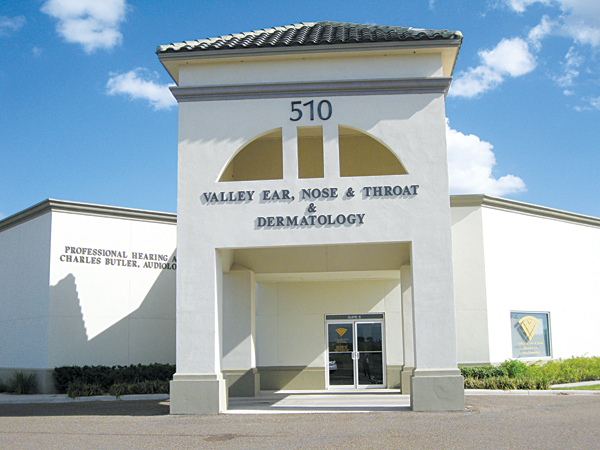- La Feria Community Holds Succesful Business Mixer Event
- Little Nashville to Take Place in Downtown Mercedes
- Lions Basketball Captures District Gold
- La Feria ISD Students Compete in Regional Chess Tournament
- Lions End First Half of 32-4A on a High Note
- La Feria ISD Held Another Successful Parent Conference
- Strong Appearance for Lions at Hidalgo Power Meet
- LFECHS Students Get to Meet Local Actress
- Students Participate in Marine Biology Camp
- Two LFECHS Students Qualify for All-State Band
A Message for Sun-Worshippers
- Updated: August 30, 2013

Doctor James Campbell cautions against too much Sun. Photo: Bill Keltner/LFN
Noted Dermatologist Talks About Skin Care
Without a doubt, the blazing star we call our sun is your best friend for without the sun, there would be no life. Every living thing depends on the sun’s rays, from the process of photosynthesis to the production of essential vitamin D in humans.
However, too much of a good thing can be harmful. Your good friend, the sun, could become your skin’s worst enemy if you get too much.
To learn how to better benefit from the sun and protect your skin, we spoke with noted dermatologist, Dr. James Campbell. The doctor has been caring for Valley patients since 1994.
The doctor stated that long-time Valley residents, as well as people newly arriving from the North, don’t realize the strength of the sun’s rays in our sub-tropical location. They do permanent damage to their skin before they even know it; damage that will show up later in life.
The doctor underscored that remark by saying, “skin cancer is increasing at an alarming rate, not only here in the Valley, but worldwide,“ then he added an explanation: “People are living longer, they have more money and leisure time to get out in the sun on cruises and beach vacations and the like…and they are showing more skin. Some make it worse by baking themselves in sun-tanning booths.”
“Prevention is much better than the cure for skin cancer,” asserted the doctor. He explained that the culprit in sunlight that causes skin lesions and cancers is the ultraviolet UVA and UVB rays. “But, modern sunscreen preparations block out both the A and B portions, and are very helpful,” he said. “The older sunscreens only blocked out the UVB rays. Using modern sunscreens and reapplying them every 80 minutes and after swimming, allow us to stay in the sun longer, but you can still get hurt by being careless about staying too long.”
“You want to make sure you have protection against both types: UVA and UVB rays,” he said, adding, “you want to look for a product containing Zinc Oxide or Avovenzone 3%.

Doctor Campbell and his staff – (left to right) Priscilla Garcia, Receptionist; Christina Castillo,CMA; Dr. James C. Campbell MD; Lisa Gutierrez, CMA.
A mistake many people make is assuming that if you are in a car or are fully dressed, you are safe from the sun’s damaging rays–not necessarily so,” said the good doctor.
‘UVA rays, for example, go right through the window glass in your home or automobile. Those are the rays that cause thinning, wrinkling and sagging skin–is that enough reason to pay attention?”
Well, I’m O.K. you say; I cover up with protective clothing. Let’s see: “There is some protection from dark-colored cotton and polyester clothing, but sun rays go right through white T-shirts, long-sleeved shirts and blouses–no protection at all. Look for a high UPF rating on clothing and a high SPF rating (at least 30) on sun screens for the best protection.
Doctor Campbell explained why this protection is important: “Just a few significant sun burns (severe reddening or blistering) in your life, greatly increases your probability of getting a skin cancer later in life,” then, he added, “Many types of skin lesions can be cured if they are caught in time–if not treated early, they can become metastatic, invading other tissues.”
Campbell explained that the most common skin cancers are (1) Basal cell, and (2) Squamous cell carcinomas. He said that Basal cell cancers were once called, “Farmer’s Tumors” because farmers, like sailors, were so prone to sun-caused skin lesions. “Both can usually be cured with standard or cryosurgery by a competent dermatologist if caught early,” he said. “Prompt” is the operational word here,“ Campbell said. “There are two more dreaded types of cancers that are often fatal: Malignant Melanoma and Merkel Cell Carcinoma. Early detection is very important.”
Dermatologists often treat a pre-cancerous skin lesion called Actinic Keratosis–this abnormal condition is likewise caused by the sun. It isn’t a cancer yet, but needs to be removed–often only by freezing in the doctor’s office. It is nothing to put off, because it isn’t going away.
So, who needs to see a dermatologist? Doctor Campbell stated that it begins with the individual himself noticing something new or strange on his skin. Next, a visit to your primary caregiver (your family doctor). If he sees something suspicious, he’ll recommend a competent skin specialist, a dermatologist.
It is best to go that route, as some insurance companies will not pay without going through your primary caregiver. Best to check if you are covered by your insurance company or not. An individual can also check this out on the Internet link to your company or PPO provider.
There is a well-known Mexican Dicho that states: “De los parientes y el sol, entre mas lejos mejor.” It translates: “From the relatives and the sun, the greater the distance the better”—Maybe they knew something.



